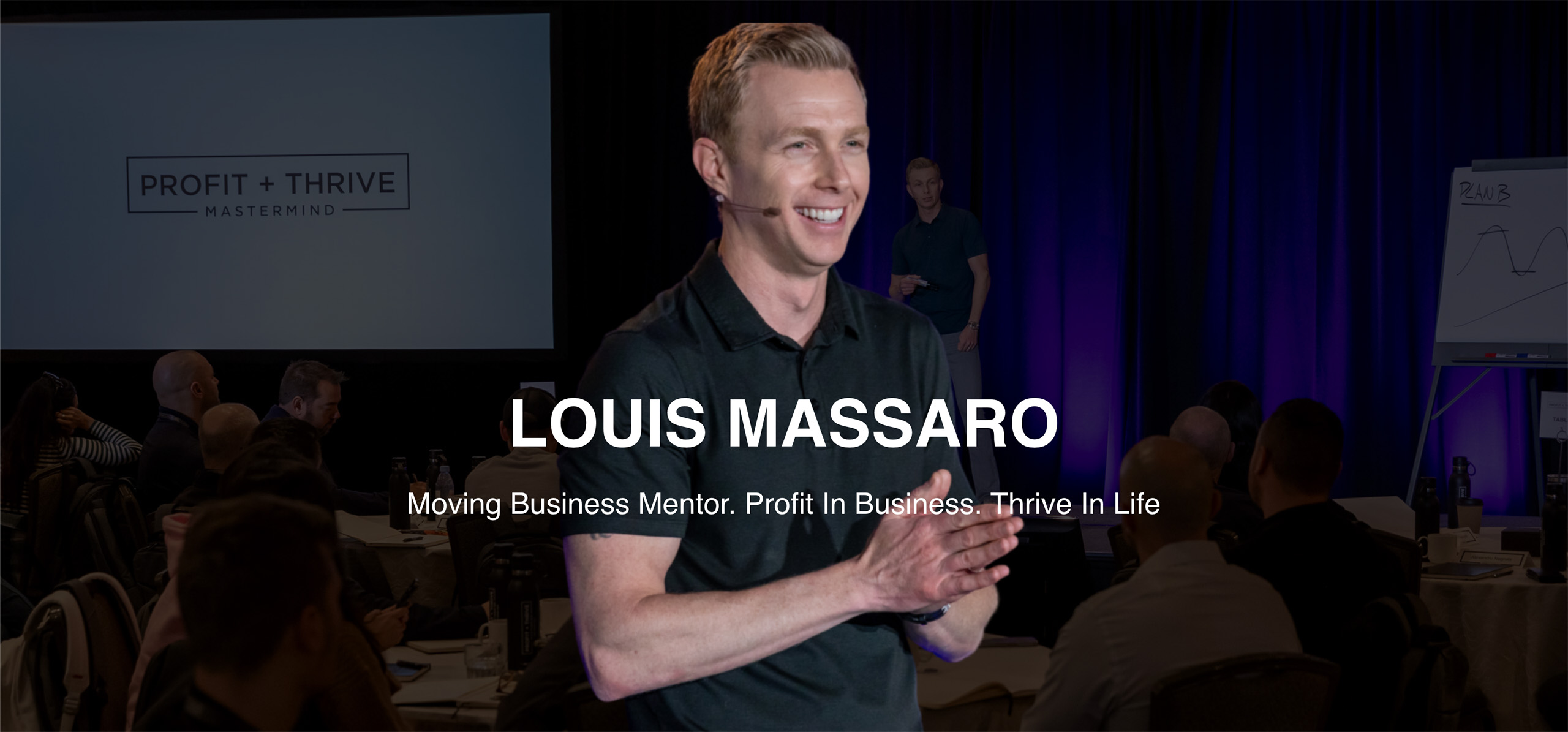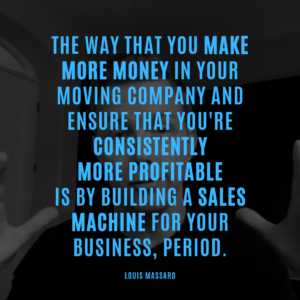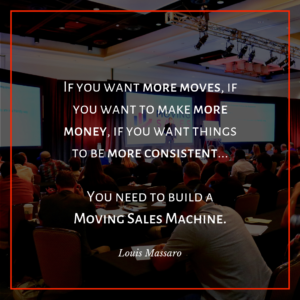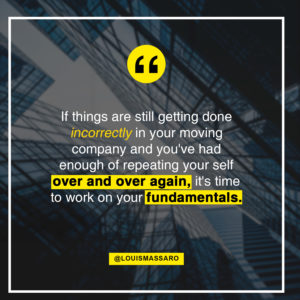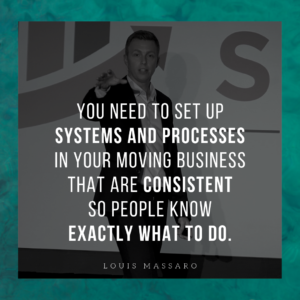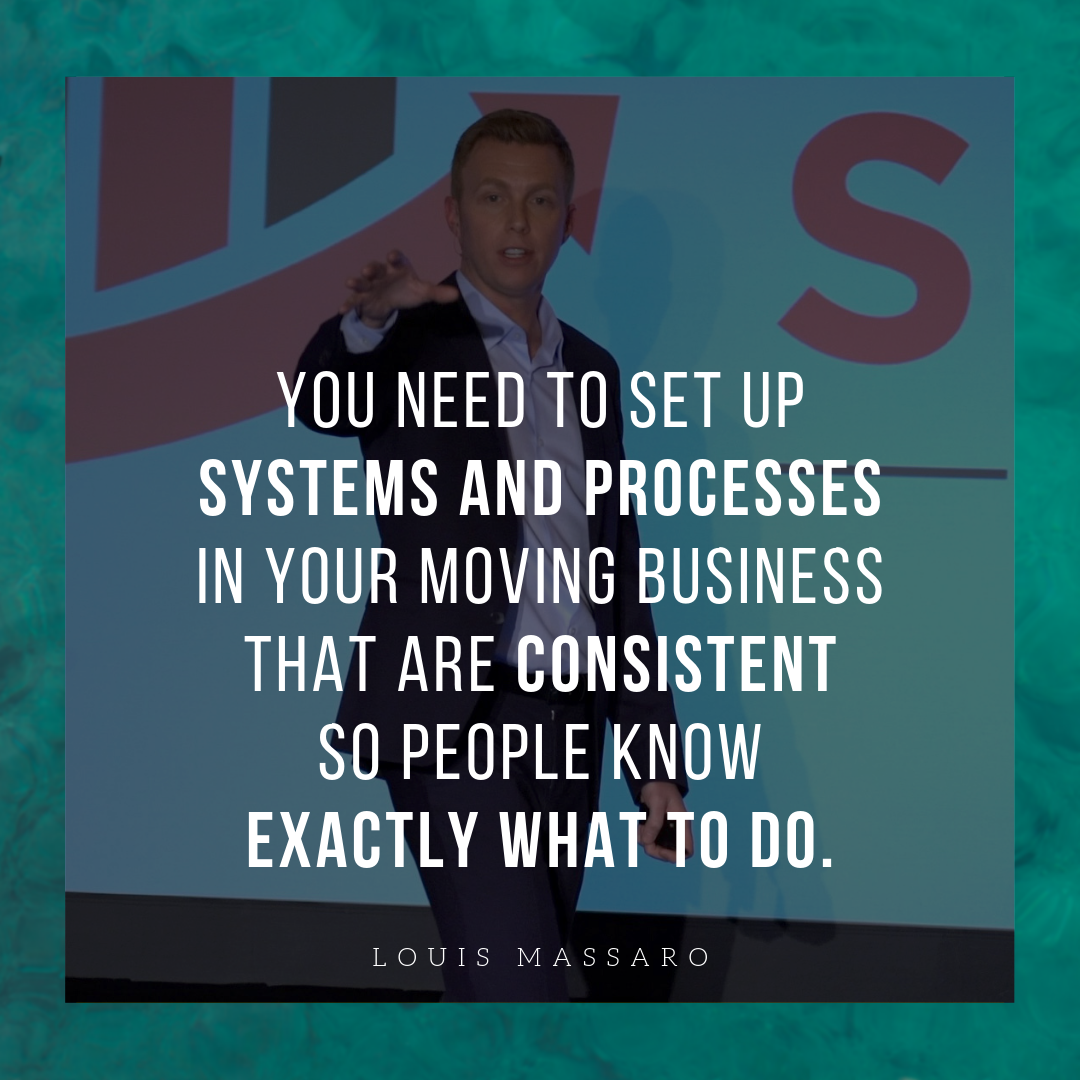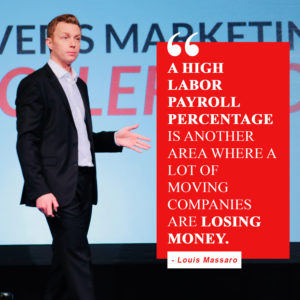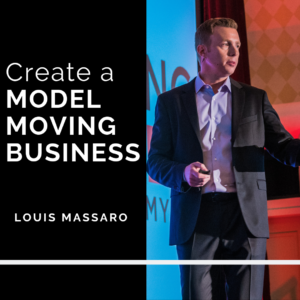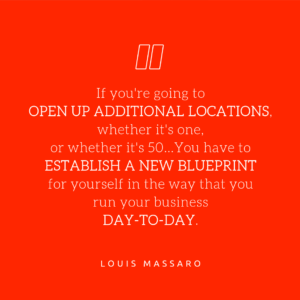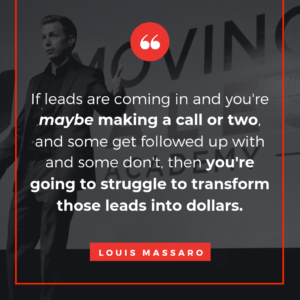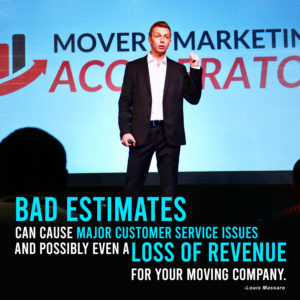SUMMARY
In this video, Louis Massaro shares how to take control of your moving company.
- “If you’re low on cash flow and you’ve got a $75,000 employee that’s not doing what they’re supposed to do, that’s an easy target. Send him on his way. It is what it is. It’s part of business.”
- “Sometimes you’ve got to go back and work IN your business in order to be in a position to successfully work ON your business.”
- “Never go and work IN your business after you’ve already removed yourself, just to cover somebody, or just until you get somebody new, or until you hire somebody else. Make use of that time. Build that department out the right way… Build the processes.”
- “Pick five to ten areas where you know you can improve. Take those, put them in order of priority. Which one will make the biggest impact in my business now? And just put them on the calendar and start chipping away one at a time.”
- “Get the ego out of the way. Stop making excuses. Stop blaming it on other people. Nobody’s coming to rescue you. You’ve got to step up and you’ve got to take the action you need to take.”
- Watch the video to get full training.
HOT NEWS & DEALS!
- Join the Moving CEO Challenge: Official Louis Massaro Community Facebook Group! A place for moving company owners to connect, share ideas, and inspire one another. Click here to join!
- Latest Instagram!
Check out @LouisMassaro for new announcements, valuable tips, and enlightening videos to take your moving company to the NEXT LEVEL!
RELATED POSTS
The Role Of A Moving Company’s Operations Manager
Why Your Moving Company Is Losing Money
How Much Should Moving Companies Profit?
How Your Identity Is Preventing Your Success
Should You Diversify Your Moving Business?
TRANSCRIPTION
Louis Massaro:
Hey, my friend, it’s Louis Massaro, and welcome to The Moving Mastery Podcast. I’ve got my main man Chris here today. What’s up, Chris?
Chris:
Hello.
Louis Massaro:
Listen, the purpose of this podcast is to help you take your moving company to that next level, whatever that is for you. This is for moving company owners. This is for anyone working for a moving company and wants to help take that business to the next level and provide value. I promise you will get practical takeaways that you could apply in your business so that you could start making more money, live a better quality of life, reduce your stress and go make it happen. We’ve been doing these new episodes where Chris is finding questions, either in my social media feed or questions that come in through support and surprising me with them on these episodes. He’s like, look, I think that the best way that you could be serving and helping people is, let me just drop some of these questions on you without you having any time to think them through. Let’s just see what comes out of it.
Chris:
We got to keep you on your toes.
Louis Massaro:
Yeah. So, what do you got? A question today or?
Chris:
I do. This one I think you’ll like. Recently, we had a very long email come into our support desk. I read it and …
Louis Massaro:
It’s a customer or a client or?
Chris:
Yes. He’s just a guy who had a question.
Louis Massaro:
Okay.
Chris:
I thought I should maybe give him a call, so I did.
Louis Massaro:
Okay.
Chris:
Okay. He explained his situation. I wanted to see how we could help him. He explained the situation to me. I took some notes here. Basically, he’s got a good size moving company. He’s doing about 1.4 million. He’s having an issue with his sales manager … I’m sorry, ops manager/dispatcher. The guy’s playing dual roles there. The issue he’s having is, he doesn’t feel that the ops manager is pulling his weight and he says this because he feels like he’s paying him too much.
Louis Massaro:
How much?
Chris:
He’s paying him about $75,000 a year. He feels like the ops manager just isn’t pulling his weight. They’re having some issues. They’ve been missing some moves. There’s some issues with not having enough movers to cover the jobs and the ops manager has just been kind of dropping the ball. Aside from that, there have been some cash flow issues. He’s already in the red for his January P&Ls. He said he was about $26,000 in the red.
Louis Massaro:
For the month of January?
Chris:
For the month of January. Yeah. I wanted to just throw this situation at you and ask you what you think. How would you help this guy?
Louis Massaro:
Was the only issue that he expressed was his problem with the ops manager and then cashflow? Is that …?
Chris:
Yeah, pretty much. I think he’s having some issues with the slower months during the winter and just the general cash flow for the business. Yeah.
Louis Massaro:
But the ops manager’s not doing what he’s supposed to do.
Chris:
That’s a big part of it.
Louis Massaro:
Yeah. Okay.
Chris:
What do you think?
Louis Massaro:
Well, obviously I don’t know enough about it. There’s a lot that leads to being $26,000 in the red in January, not just the ops manager. Who else does he have any office? Did you get into that? I’m sure you asked him.
Chris:
He’s got a small sales team, like three salespeople.
Louis Massaro:
So, it’s him, three salespeople and this ops/dispatcher?
Chris:
That’s it.
Louis Massaro:
Doing a million four.
Chris:
1.4.
Louis Massaro:
Okay. There’s not enough information to really dive into why he’s $26K in the red, but right off the bat, I could tell you that if you’ve got an ops manager/dispatcher who’s not doing what they’re supposed to do and they’re making $75K and you’re losing $26,000 a month, it’s time to make some massive changes. The first thing I would do is I would … Listen, it’s not about, you don’t have the money, cut people, but it is about if the guy’s not the right fit and you’re bleeding out money, get rid of him.
Chris:
Yeah.
Louis Massaro:
Right? It’s a much harder decision when somebody who’s really good and you’re having cash flow issues and you’re concerned what you should do, but if he’s clearly not the right fit, get that money back. Meaning like, cut that salary and go do it yourself. At a million four, go back into the business. There’s a reason that the ops manager’s not doing what the ops manager is supposed to do. It sounds to me like he’s probably just a dispatcher. A lot of people will call a dispatcher an ops manager, but it sounds to me like that’s probably what he is. I don’t know. $75,000, it’s more ops manager pay.
Chris:
Yeah. Well, a lot of those issues were coming from scheduling issues, movers, not having enough movers, jobs getting missed, things like that.
Louis Massaro:
Yeah. There’s a bigger issue here at hand. Let’s just say you’ve got some stuff out of control, right? Right now what I would do … here’s the questions that I would want to guide him through to get more information. I would want to understand what it is that the ops manager is not doing, what it is he’s asked him to do that he’s just blatantly not getting done. The best thing you could do in that situation, it’s like, look, if you’re low on cash flow and you’ve got a $75,000 employee that’s not doing what they’re supposed to do, that’s an easy target. Send him on his way. It is what it is. It’s part of business. Send him on his way and go back and sit in that dispatch seat yourself as the owner of the company, and then this time you do it right.
Louis Massaro:
This time you go in, and while you’re sitting in that seat … Look, we talk about you want to work on your business and not in your business, right?
Chris:
Yeah.
Louis Massaro:
We say that all the time, but sometimes you’ve got to go back and work in your business in order to be in a position to successfully work on your business. I remember, man, what year was it? I had five locations already. I had the call center going. I had stepped into this moving CEO role that we talk about where I was running the business off of meetings and numbers and block time on my calendar. We had a dispatcher in that same location in that South Florida office that was just the same kind of situation. Wasn’t pulling his weight, wasn’t doing what he was supposed to do, had systems, had processes, but just was just … I don’t know, had personal issues. I don’t know what was causing him not to do what he was supposed to do, but it came to the point I was like, you know what? Enough’s enough. He’s got to go.
Louis Massaro:
Luckily, I was in a position at that point where I wasn’t tied to any specific function of the business. I had kind of stepped into a role, the moving CEO role, right?
Chris:
So you weren’t involved in the day-to-day …
Louis Massaro:
The day-to-day could run without me. Everything I was working on projects and building the business and proving things, and I was like, you know what? And I love to dispatch.
Chris:
Really?
Louis Massaro:
Yeah. When I first started it was like, man, to sit and have like 50 jobs on the calendar for the day and try to get them all service, it was …
Chris:
That’s kind of fun.
Louis Massaro:
It’s so fun.
Chris:
That’s where all the action is.
Louis Massaro:
And it’s so satisfying to be able to have this schedule that feels like, man, how are we going to get this done and then pull it all together? I enjoyed. I hadn’t done in a long time. So I said, you know what? I’m going to fire him and I’m going to personally go do it. This time I’m going to go in and I’m going to totally make sure that … I’m going to refine tune it. The processes, maybe they were outdated a little bit, maybe they needed to be tightened up, maybe they needed me to come in and look at it and go, “There’s gotta be a better way. There’s gotta be a better way.” So I did it in the middle of the summer and it was two or three full months that I dispatched while running the call center while running for other locations. I went back in and I tightened that up so much that the next guy that came in, I set him up for success.
Louis Massaro:
Not too long ago, I was telling this to a private client and he went and did the same thing. He went in and said, “You know what? I’m sick of this shit. I’m going to go in and I’m just going to clean house and do it myself.” He had been so far removed. You know who I’m talking about. He’s got the franchises.
Chris:
I’m pretty I know who you’re talking about. Yeah.
Louis Massaro:
So, he went in and cleaned house, sent me a picture of the desk, and was like before and after, and it was like a total disgusting, just gross looking desk, unorganized as could be, and then a nice clean, methodical desk. And he’s like, Look, I did it. It’s on point. I’m training somebody new now and it’s night and day.” The point I’m making is, for this guy, and we won’t say … don’t say his name, whoever he is.
Chris:
No, no, we’ll respect his privacy. Yeah.
Louis Massaro:
Yeah. So, you got to go back in, you got to get in that driver’s seat. There’s a reason you’re losing $26,000 a month and it’s not because your operations manager is not listening to you.
Chris:
Is that a step backwards? Should an owner feel bad about doing that?
Louis Massaro:
No, absolutely not. I think that a lot of times we see company owners that need to make these kind of moves, right? This is probably way overdue, right? The $26,000 in the red on his P&L in January, is that right?
Chris:
That’s what it was. $26K, yeah.
Louis Massaro:
That didn’t happen overnight. There’s a longer issue here of just, probably if I had to guess, things are just not being run tight. So you’ve got somebody making too much money. Okay, you’ve got a department that’s not performing the way it’s supposed to. You’re a smaller company. $1.4, it’s a good size company, but it’s not a huge company where you’re so far removed from the day-to-day. I would fire the guy and go in there and set it up right this time. Go in there and say, what can be done better? How can this be done better? And start laying out processes. if you’re ever going to take … it’s not a step back at all. It’s like, let me go do what’s going to make the biggest impact in my business, and what’s going to make the biggest impact in the business is not just hiring a replacement and bring in that replacement to work with a disorganized department, is what it sounds like. Let’s just call it what it is.
Louis Massaro:
We could put the blame on the ops manager, but part of that might be the ops manager and part of it might be lack of direction as well. Let’s not bring somebody else in to then deal with that mess. Let’s go in and take the time to build that department out the right way. While we’re there, build the processes. I keep saying that because never go and work in your business after you’ve already removed yourself just to cover somebody or just until I get somebody new or until we hire somebody else. Make use of that time.
Chris:
It’s an opportunity.
Louis Massaro:
It’s an opportunity because the only way you can really create a process is by doing it.
Chris:
That’s true. How would you know?
Louis Massaro:
You can’t sit from afar and go, okay, I’m going to … you should do this, this, this, and this. You could start that way, but then it has to be tested to see if it works correctly. That would be the first thing I do. Second thing I would do is I would look at these three salespeople and see how they’re performing. I would look at the three salespeople. I would pick a few calls from each of them to listen to. Hopefully, he’s got a script. Hopefully, there’s some structure there, but he’s got to listen to their calls and see what it is they’re saying. Look for their closing techniques. He might not know what to look for. I think there’s enough free videos on my website.
Chris:
LouisMassaro.com. Yeah.
Louis Massaro:
Yeah, and on this podcast that nobody even has to buy anything to get some little basic tips on things to look for. But you’ve got to make sure your booking percentage is up, because your $26,000 in the hole, it’s because your labor cost is too high, meaning you’re not charging enough for your moves. Let’s say your average move is $1,000 and you’re paying out $400, you’re paying out 40% of every move in labor, it’s either you’re paying your movers too much or you’re not charging enough for your moves. Most times it’s that you’re not charging enough for your moves. Man, sales solves so much. You get the sales process dialed in, it solves so much. You got these three people. If these three people are burning through leads, not following up with leads …
Chris:
You’re losing money.
Louis Massaro:
… not closing at a higher percentage, if he doesn’t know his marketing ROI to understand which lead sources are actually profitable. The $26,000 is going somewhere. The money’s coming in the top. Did you get a gross number for January or no? You just know 1.4 for the year?
Chris:
Yeah.
Louis Massaro:
He’s probably … I don’t know. I’d say he’s probably maybe $80,000 or something for January, maybe even less. I don’t know. To be …
Chris:
But just bleeding.
Louis Massaro:
Just bleeding.
Chris:
Yeah.
Louis Massaro:
There’s a bigger issue and something led up to that, and we don’t know if his books are accurate either. That $26,000 could be stuff from the previous month that was recorded on this month. He could have like double rent payments on his books if it’s not done right based on just how it’s being recorded. Regardless of all that, we don’t have enough information to fully give this guy a prescription on what to do, but we’ll talk in general, right?
Chris:
Okay.
Louis Massaro:
He’s got to get rid of the sales manager. He’s got to go in and tighten up the sales process. Listen to the calls of each rep, see where there’s opportunities that they’re missing. You want to make sure that they’re going for the sale. You want to make sure that if a customer has any type of, “Hey, I need to check around or whatever,” they don’t just say, “Okay, great. I’ll call you back.” You need to make sure they’re capturing lead data. Somebody calls in for a quote, they’re putting that information into your system. Those are your leads that you’re paying for. I could almost guarantee you that his sales department is needing a revamp.
Chris:
And you think he should raise the rates?
Louis Massaro:
No, I’m not saying he … I don’t know what he should do. I don’t have enough information to really … I don’t want him to listen, “Oh, that’s me,” and go, “This is what I should do.” I’m saying, if anyone’s struggling with cash flow, there’s a bigger issue at hand. You’re either paying too high of labor. Which again, I’m repeating this because I just want … you’re paying too high in labor percentage. Not that your movers are getting too much, you just might not be charging enough. There’s two ways to lower your labor percentage, and it’s either you lower what you’re paying your movers or you increase your price.
Chris:
So it’s more of like a per-job basis than overall.
Louis Massaro:
Yeah, overall. well, revenue, I do it on a weekly basis. If you brought in $100,000 in a week, you paid out $25,000 in payroll, it’s 25%. Right?
Chris:
Yeah.
Louis Massaro:
Usually, lowering your movers’ pay isn’t going to result in anything good.
Chris:
They won’t be happy about that.
Louis Massaro:
You might have a little mutiny on your hands. So you need to raise the prices, but in order to raise the prices, you’ve got to be able to have a strong sales process. There’s a lot to that. You could go look for all the sales material on my site or this podcast and start listening to that, or you’ve got office staff that’s getting paid too much. For $75,000 in $1.4 million company, you should have been kind of running the day to day of this business.
Chris:
Yeah. He does do a lot of day-to-day stuff. Now, as someone who …
Louis Massaro:
Day-to-day as in like not just operations, not just dispatch because if he doesn’t have a dispatcher, this operations’ manager is probably spending most of his time dispatching trucks, dealing with movers in the morning, dealing with the customers during the day, dealing with the movers when they come back. He’s not running the whole business, I would imagine if there’s not another dispatcher there.
Chris:
For someone who decides, okay, I’m going to go back into the business and I’m going to wear this hat, how long does it take to revamp that position and get everything where you want it to be?
Louis Massaro:
It all depends. You might open up a real Pandora’s box.
Chris:
You might discover some secrets. Yeah.
Louis Massaro:
Yeah. These types of things happen. To me, I see it happen to people, and even with me, in situations where like, you know you should have handled this a long time ago, you know you should have dealt with it a long time ago and you just kind of let it linger to the point where you’re $26,000 in the hole in a month, to the point that the ops manager’s not listening to you and doing the things that you need … You should have handled that a long time ago. The minute you realized he wasn’t the right fit, you should’ve gotten rid of him.
Chris:
It’s just been festering there for a while.
Louis Massaro:
It’s just been festering.
Chris:
Yeah.
Louis Massaro:
Yeah. I think that it could take, listen, it could take a few weeks or it could take a few months. The key is not to put yourself … You go in on a mission. Don’t take this, “Ah, honey, you won’t believe it. I’ve got to dispatch trucks again.” Be excited about it. Be like, “I’m going to turn this shit around. I’m going to fix this now.”
Chris:
Right. It’s time.
Louis Massaro:
It’s time. Don’t be afraid of … a lot of times people will be afraid of, “Oh man, my movers are going to …” You feel like you’ve got to be perfect because you’re the owner.
Chris:
Yeah. Everybody’s looking.
Louis Massaro:
Everybody’s looking. The reality is you can call on the people around you for help. You could talk to your movers, “Hey, help me out. How was he doing this before?” That type of stuff. You don’t have to know everything. You just have to be able to get the access to know everything.
Chris:
Let’s just say like in this particular situation, maybe instead he was paying the guy a reasonable salary, but there were still some issues, and he decides as the owner, you know what? I don’t want to get rid of this guy, but I do want to revamp the position. How do you do that without taking over the position yourself?
Louis Massaro:
First of all, you want to always look at … the problems come in one of two ways, right? It’s the people or it’s the process. Every problem you’re having in your business is either the people or the process or the person and the particular process. I always would look at the process first instead of blaming the person. It’s easy to blame the person. The reality is, did you take the time to lay out exactly what they’re supposed to do or did you think that they’re going to read your mind and just do a good job? Work hard, do a good job, hire movers and they’re supposed to figure out how to do it. So, you could go work along … Let’s say, like you said, he’s okay. It’s not that he’s not listening and he wants to keep him around, he just wants to revamp the department.
Louis Massaro:
Go into that department for two weeks. If you’re listening and you have any department sales, your warehouse, storage, movers on the job, doesn’t matter. You go into that department for two weeks and that’s all you do is spend time in there saying there’s got to be a better way, there’s got to be a way to fix all this that’s going on and develop processes that will make it run smooth. Like, oh, wow, we’re dropping the ball here, we’re dropping the ball there. How can we fix that? That’s just a communication issue. The salesperson’s not putting in the proper notes into the CRM, well, the dispatcher’s not able to see exactly what needs to happen on that job. So how is he supposed to tell the movers what to bring? And you follow it. You see what I’m saying?
Chris:
Yeah.
Louis Massaro:
You just start to identify what the root cause of the issue is. You don’t go in there and just start putting bandaids on a bunch of stuff. You look for the root cause and know that this will be one of the most transformative things you could do for your business. I’ve advised many people to go do this in different departments. You’re having an issue? Good. Go spend the next two weeks in that department and don’t do anything else.
Chris:
How long did you run dispatch?
Louis Massaro:
It was two or three months. I forget. It was at least two months, but it was the middle of summer.
Chris:
Okay.
Louis Massaro:
Yeah. I was kind of having fun.
Chris:
And you found somebody to fill the position. You had all the processes laid out for them, so they walked in and were able to be successful right off the bat. Then, what differences did that make in the company? Did you see …?
Louis Massaro:
Oh, it’s huge. There’s my story and then there’s the stories of our clients. I think of so many scenarios where myself or someone else went into a department, and you’re like, “I’m going to fix this department.” Maybe they fixed that and that was the end of it or they fixed that and then they realized that, oh, this other area needs some help.
Chris:
You discovered somewhere else that …
Louis Massaro:
Yeah, it’s like if you go in and remodel a house, you’re like, “Oh, we’re going to get this house. We’ll just remodel the kitchen and the bathrooms,” and then all of a sudden, they look so fantastic, you’re like, “Man, we’ve got to redo the whole house.” That happened to me before. The thing is, it starts you on this path where it seems scary. You don’t want to jump in right away. Everybody resists it. I resisted it. The people that I give this advice to resist it. They don’t want to do it. They don’t want to go back to getting on a truck. They don’t want to go back sitting in a dispatch seat and get to the office at 6:30 in the morning. They don’t want to go back to calling leads and having to do all that stuff.
Louis Massaro:
But you’ve got to look at what’s beyond that. It’s either you’re going to always struggle to figure out the same thing over and over and over, or you just take the time right now to go in and not go in with bandaids, but go in and perform surgery, fix that area, and you know what? If that new well-performing area starts to highlight another area that seemed okay before, but now that this one’s so good, this one doesn’t seem as good anymore, great. Go spend a couple of weeks there and work on that. Focus your attention on what’s going to make the biggest impact in your business, but make sure that as you’re doing it, you’re leaving processes behind you, you’re leaving role descriptions behind you.
Louis Massaro:
If he’s sitting in the chair of dispatch and doing that for a few weeks, he needs to be also working on the role description. What is it that I want a dispatcher to do exactly?
Chris:
Laying it out.
Louis Massaro:
Not their processes, because processes and role description are different. Role description’s like, I want them to dispatch the trucks every morning by 6:30 AM. I want them to clock out the crews. They’re writing out a description of what they would do. And then, morning dispatch in and of itself would have its own process. Clocking out the crews would have its own process, but what is it I want from this individual? Then when you go to hire that person, you know exactly what you’re looking for. Instead of just hiring someone where you’re like, “Oh, they seem like a good person,” you’re like, “No, this is exactly what I need.” It becomes essentially also your job description and what you’re able to talk to somebody about with what you’re looking for in the position where … I know from my early days and I know from working with people, a lot of times you’ll sit down to hire somebody and you’re like, “Yeah, we’re looking for somebody. This is kind of what you do and this is kind of what you do and here’s what’s going on.”
Chris:
Sit and watch this guy for a while.
Louis Massaro:
Sit and watch him and you’ll kind of see, and that’s it. If you could be specific, this stuff changes your business. The point I want to make is don’t be afraid to go back into your business. Don’t feel like you’re taking a step back to be able to do it. For me, early on, I opened multiple locations and then I had issues. The guy who was running my main location just wasn’t doing a great job. So, I had to go-
Chris:
And you’re somewhere over here.
Louis Massaro:
Well, I’m somewhere over here, so I had to then go over there and do the same thing. Now that I think about it, I actually had to go back into dispatch several times while I was growing all the locations. I’d have to go and sit at that office for a few weeks to a month. This is early on before I had the set processes that were uniform across the locations. It was a struggle to refigure it out, bring somebody in, retrain them during this whole process of flying back and forth to locations, dealing with this. This is when I’m like, no, no, it’s got to be uniform.
Chris:
Oh, your plate’s spinning. Yeah.
Louis Massaro:
Yeah, it’s got to be uniform across the board. Everybody’s got to do it the same way or I can’t tell if they’re doing it right.
Chris:
Yeah. That’s cool. For somebody who has, let’s say they’ve gone into the business, they’ve re-establish the roles, the processes for that position, they’ve cleaned it up. They’ve cleaned up the mess. They feel confident. They hire somebody else, bring them in and they step away to go back to working on the business.
Louis Massaro:
You’ll be a different person. That process will make you a different person. All the fear, uncertainty and insecurity that you feel in your business is because of your lack of control of what’s going on. When you go back in and you get that control again, you got your hands on it, you’ve got your hands on the steering wheel, like you’ve got it, and then you design it in a way with your current level of knowledge, experience and ability to implement and with this information and then you step away, you’re stepping away knowing that person has a role description, they’ve got processes to do what they need to do. I have ways for checks and balances to know what’s going on. I’ve got time set up to meet with them to make sure that our agenda’s where it needs to be and we’re moving things along. I know my numbers and metrics and all that. You’re a different person. You know what I mean? You come out of it stronger.
Chris:
Yeah. The confidence is there.
Louis Massaro:
The confidence is there. Hopefully, you learn like, okay, I can’t just move so quickly in trying to grow that I sacrifice setting things up the right way in the foundation so that I have something to actually grow on and stack on instead of doing it on quicksand. I think, if you’re in this position, you’re thinking about, okay, I’ve got to go back into the business, or you’re having cash flow issues. You’ve got to look around too and say like, everybody that I’ve got on salary, are they holding their weight? Are they worth that? We’ll see a lot of times, people will have way too much office staff, what do you have going on?
Louis Massaro:
The reason somebody ends up with all that office staff is because of inefficiencies within their processes. If you’re able to go in there and streamline all that and go, “Well, this takes 10 steps. How could we just do it in two steps? Why does all this work have to be done by the bookkeeper when the CRM could just integrate directly with QuickBooks and that eliminates the need for that?” So you start to find all these areas where you could make it more efficient and now you don’t need all these people, which is another cause of why somebody would be $26,000 in the red is that their fixed payroll is way too high.
Chris:
That’s what I was going to ask you, is if, let’s say things are going well and you’re not having issues, but you know there are probably some inefficiencies, there are probably some unnecessary steps and tasks going on within the company. Would you recommend an owner step away from the business to go work on that when things are going well or should they just wait until there’s an issue?
Louis Massaro:
I would say that if you’re looking to optimize your business and you know that you could be doing better in certain areas, analyze what those are, and if you’re unsure, what I used to love to do is I used to like to go sit in a department for a few days or a week.
Chris:
Regularly?
Louis Massaro:
Yeah. When I felt that there was something there that could be improved, and I would just sit there and take notes and not say anything to anybody. So I’m just going to hang out [inaudible 00:31:24] like customer service or sales or dispatch and just kind of see how things went. I would never, ever, ever interfere at the moment. If I saw the dispatcher to doing something that was just wrong, I wouldn’t say anything at the moment.
Chris:
You wait.
Louis Massaro:
I’d wait because otherwise now he’s on eggshells and it just creates … and I want him to do his normal thing. I don’t want him to be on his best behavior because I’m there. So I wait and I just make notes and I look for areas that can be optimized. We talk about gaining freedom and be able to work … That’s working on your business. That’s not working in your business. Working in your business would be to be the dispatcher, but to go sit in a department and observe it for ways that you can make it better so your customers get better service and you make more money, that’s working on your business. When you identify like, I’m sure if you’re listening right now, get out a pen, get out a piece of paper, just write down off the top of your head. I bet you you’ve got five to 10 areas where you know you could improve right now.
Louis Massaro:
Five to 10 areas where you know you can improve. Take those, put them in order of priority, which one will make the biggest impact in my business now and just put them on the calendar and start chipping away one at a time.
Chris:
Yeah.
Louis Massaro:
Yeah.
Chris:
Is there a way for an owner to … when they’re in that position, is there a way for them to not let the other responsibilities they have or for them to continue working on growing the business and scaling at the same time or should they just put that on hold and just focus on doing the dispatch for the next two weeks and that’s it?
Louis Massaro:
It depends. A lot of people are trying to scale before they have the foundation under control, which is …
Chris:
Bad idea.
Louis Massaro:
It’s such a bad idea. I did it. The only reason I was able to recover from it is because I was a young kid that didn’t have any responsibilities as far as family or kids or anything like that and I could work all these hours and fly all these places to keep it all under control. But if you start to scale and grow, meaning like open another location or open another division or something like that, when your foundation isn’t on point, you’re always going to end up back in that dispatch seat. You’re always going to end up back on that sales floor.
Louis Massaro:
You’re always going to end up back dealing with your long-distance trucks. You got to be able to look back and go, okay, let me look at the history of my … let’s say you’ve been in business 10 years. How many times did I have to go back to the drawing board? Go back to the drawing board. I was like, and now I got a good ops manager, I got a good sales manager. Oh, it’s cool right now for a few months.
Chris:
Take a break.
Louis Massaro:
Then something happens and then you’re back there. If you take the time, like for me, if young me was listening to this, I’d feel like it was some old dude giving me advice like, “Slow down.” And it’s not that. You can’t build if you don’t have a foundation. You’ve got to take the key areas. You’ve got to make sure you’re generating leads, booking moves, servicing moves, making sure your customers are happy and giving you five-star reviews, and then your accounting, your reports and all that. You’ve got to make sure that that stuff is on point. Once it’s on point, you could build on that. You could build on that, and you’ve got to make sure that your team is pulling their weight, and sometimes we overreach. Sometimes we overstep. Sometimes we hire a big position or we open another location or we get into another division.
Louis Massaro:
We started doing long-distance or we start doing commercial, we get distracted. If you find yourself in a place where you’ve kind of overreached and that one little overreach is causing issues everywhere else, don’t be afraid to pull back on that. Don’t be afraid to let people go. Don’t be afraid if you open an office three years ago and it’s doing nothing but losing money and it’s taking your time and energy away from your breadwinner, your main office. It’s either you’ve got to take enough massive action to go and get that other office under control and profitable now without just assuming that it’ll get profitable, or shut it down and focus on where you make money. We’ve only got so much individual bandwidth and energy.
Louis Massaro:
If you’re being diverted in all these nonproductive ventures or with these non-productive employees, you could streamline, make it easier on yourself and make more money.
Chris:
You’re not failing.
Louis Massaro:
You’re not failing.
Chris:
Yeah.
Louis Massaro:
You’re not failing.
Chris:
There’s no shame in getting your focus.
Louis Massaro:
Yeah. There’s no shame in that. It’s a shame that people will be so afraid to “fail,” that they’ll keep pursuing the wrong thing.
Chris:
What do you mean?
Louis Massaro:
Let’s just say they’ve got … I don’t know. I’ve seen people where they’re so excited to get into military or they’re so excited to get into commercial or they’re so excited to get in the long-distance, and they do it and it’s beyond their current bandwidth of what they can really handle. They underestimated what it was going to take to really take that on and own that. They figured A, I own a moving company. No problem. I could do that too or I could do that too, or opening another office and realize that, no, no, no, no. This thing’s like a whole monster in and of itself. I see it where they’ll let it drag the good part of their company down and drag their energy down.
Louis Massaro:
So you’ve got to be able to look and say, “You know what? This is a division that’s not working. I miscalculated this.” I’m not saying just give up because it’s hard at first. I’m not saying that. What I’m saying is you’ve done everything, you’ve taken the action you needed to take. You looked at it and said, “How do we fix this?” And you went and took that action, still not …
Chris:
Still didn’t work.
Louis Massaro:
Still doesn’t work. Meanwhile, other areas are slipping. Your main business where your money’s coming is slipping, your home life, slipping, your health, slipping. But somebody won’t cut off that division and say, “You know what? Let’s go back and let’s just do local moves,” for example. “Let’s just stick with that for now and regroup,” because they’re afraid of being a failure to all these imaginary people they think are watching and caring. Listen, I could say that because I used to feel that way. You know what I mean? I’ve gone through it and I’ve grown and I’ve evolved so I know that nobody’s watching, nobody cares. If there’s an ankle weight that’s holding you back, that’s just not productive, cut it off and focus on the stuff that works and keep it simple. There’s no badge of honor for going down with that sinking ship.
Chris:
Yeah. There’s no shame in admitting that you may have bit off more than you can chew.
Louis Massaro:
Yeah.
Chris:
That’s probably a sign of business maturity in that situation when you’re able to admit that to yourself.
Louis Massaro:
Yeah, absolutely. You said it perfect, to be able to realize that you bit off more than you could chew, and that’s a consequence of being a go-getter. Sometimes that happens.
Chris:
It’s going to happen.
Louis Massaro:
You know what I mean? If you’re aggressive and you go after things, you may end up in a position where you bite off more than you could chew, but there’s a difference between, hey, I bit off more than I could chew, so for the next few months I’m going to have to make all these adjustments to handle this, and I bit off more than I could chew and now I’m just going to drag myself through the mud and suffer for the next three years.
Chris:
It’s better to just stop the bleeding.
Louis Massaro:
you got to just face facts and have zero attachment to it as a failure.
Chris:
Well, part of that, stepping away or closing down a division that wasn’t working or whatever, inevitably you’re probably gonna have to fire somebody. Right?
Louis Massaro:
Yeah.
Chris:
That’s never easy.
Louis Massaro:
No.
Chris:
How do you fire somebody? Is there a way to do it?
Louis Massaro:
Listen, the reality is you just have to do it. You just have to do it and you have to go into it knowing that that’s what you’re doing. That your decision is made. There’s many reasons for firing somebody. We’ll do in a whole nother episode on that. There’s many reasons. That you could just not afford them anymore. They’re not the right fit. They blatantly did something that violates company policy. There’s different ways of handling, but the reality is, it’s part of being a business owner. You want to be a business owner, this is the stuff that comes with it. It’s harder to be a business owner than it is to be an employee. There’s a lot of risk and there’s a lot of reward, and there’s a lot of stuff that you have to do and responsibility that you have to take, and you’ve got to be able to accept that and own it and that’s just part of it.
Louis Massaro:
The reality is, we’ll do another episode on it, but if you’ve got to do it, you just have to do it. You’re not doing anybody any favors. If you knew you needed to let somebody go six months ago and you’ve kept them all this time, you’re not helping them. They need to move on. The struggle you have as a business owner and those decisions, and when you stay up late at night like, aw man, they got a family, it’s going to be hard on them. When I brought them in, I told them that there’s unlimited potential here for them. I’ve got to let him go, but he’s such a good guy or such a good girl. You know what? That’s the stress you deal with as a business owner and them saying, “Oh, shit. I just got fired. I need to now go find something else. How am I going to take care of my family?” That’s the stress that an employee deals with.
Louis Massaro:
It’s just part of business. It’s part of how things work. They’ll be okay, they’ll find something else. It’s not the end of the world. You’ve got to be able to tell yourself to do that and you’ve got to really look and say, is this person in this position and what they do hurting me or helping me? Look at it overall, not like, well, they do some things that help. No, no, no, no. The money you’re spending, that needs to be an investment in the value that they bring to the company. If the money you spend, if they don’t bring that value and then some, then there needs to be an adjustment or they need to go.
Chris:
It’s time to go.
Louis Massaro:
Yeah. As far as this guy’s concerned, when was this, by the way?
Chris:
Last week.
Louis Massaro:
Okay.
Chris:
Yeah.
Louis Massaro:
All right. Yeah, I’d love to know more and be able to dive in and give him a direct answer, but overall, that’s what it comes down to. You’ve got cash flow issues, it didn’t just happen. You’ve got to know that December, January, February, it could happen in the moving business. There could be a dip. What you want to do is you want to learn from that. If you’re in a position where you’re struggling with cash flow right now, you’ll get through it. You’ll be okay. Maybe you’ve got to fire some people, maybe you’ve got to sell some trucks. Maybe you’ve got to cut off an unproductive money-losing division. Don’t be afraid to take the massive action to save yourself now. But then, when you’re out of it, don’t forget what happened.
Louis Massaro:
Don’t forget what you went through when summer comes and money’s flying from the ceiling and you’re throwing it up in the air like Scrooge McDuck. You need to remember that and make sure that you put some money away for the offseason. It’s the reality of the business. You’ve got to strategically plan for it and know what’s coming. It all comes back to the basics. I know it sounds like, okay Louis, that’s easy to say, but you’ve got to know your numbers. You’ve got to know where you’re at. Every day you’ve got to just say, you know what? Where do I need to go? What could I do to get myself there? It’s so easy to fall into a dark place and just feel down and out and depressed.
Louis Massaro:
I went through this in the recession. I was juggling money between six offices trying to keep everything afloat. When everything just came crashing, I had way too much money I was spending in yellow pages and I had to deal with this and felt like the whole business was just collapsing on my head. It put me into a very deep depression.
Chris:
Really?
Louis Massaro:
Yeah. I understand what it’s like to be there and it’s not like, hey, just save some money and you’ll be okay. When you’re there, you don’t want to hear that. When you’re going through it, that’s not helpful. You just have to know that all you could do is the best you could do and make sure that you’re doing the best you could do. Make sure that each day you’re taking good action. Whatever you got to do to snap yourself out of it and make it happen. That’s the only way I got myself out of the mess, was every day I was taking action, taking action, taking action. At first, it didn’t feel like I was making a dent in the whole thing, but I was chipping away, chipping away, reducing expenses, making more money here, becoming more efficient there.
Louis Massaro:
Just consistently making moves, and at the same time, putting things in place so that it would never happen again. So, it’s like if you know you’re at rock bottom, there’s only one way to go, which is up. You just have to literally go and every action you take on a daily basis needs to be leading you in that direction. You can’t sit around feeling sorry for yourself. You can’t talk about how it’s the time of year, it’s the economy, it’s my market, it’s my movers. It’s none of that. Where you’re at today is because of previous actions. I don’t say that to make you feel bad about it. I say it because you’ve got to get real with yourself. You know what I mean?
Louis Massaro:
I had to look myself in the mirror and be like, all right, enough it is. You got to step up, put your big boy pants on and do what you need to do, enough whining about this, you put yourself here, you opened up all these offices, you were overextended in this stuff, now get yourself out of it. You could do it, and then once you do it, once … I almost feel like … Everybody goes through it at some level. Everybody has those hard times. Having them over and over and over again is strictly due to the lack of commitment and decision to say like, “This isn’t going to happen again. Let me get this in order. Let me do it right this time.”
Louis Massaro:
If you’re down right now, if you’re just … Listen, you don’t have to be going through a depression. You could just be having a bad month financially. You just have to know it’s time to really get serious about it. For me, I didn’t get serious about it until that happened. I didn’t really start diving in on my numbers, diving in on my processes, all that until I had to go through those hard times because before that, I was making so much money, I was like, whatever. My accountant would be like, “You have to review your P&Ls.” “Yeah. Okay, whatever. Here they are. You review them. I got money. I’m good.”
Louis Massaro:
Listen, if this is helpful, if this information is helping you right now, listen, go back, listen to all … go back to the beginning of this podcast and listen to every single one of them. If you get tips, great. If you get inspiration, great. If you help shake off some of the fear and the uncertainty, great. You’ve got to get little bits and pieces. As you rebuild your business, you’ve got to realize that you’ve got fear of uncertainty. What will happen? I get it. What’s going to happen with my family? What’s going to happen with my business? What’s going to happen if I can’t pay these bills? What’s going to happen if I can’t pay my employees? All that stuff.
Chris:
Yeah, it can be scary.
Louis Massaro:
It could be scary, but you got to know that you could get through it. You can’t sit around and wallow in it. You’ve got to take action. Literally, if taking action means going back and spending … turn Netflix off. Listen to all of these episodes. If there’s other stuff out there, great. It’s not about that, but I know what I have to be able to help you with and it’s there, free. Go to the website, watch all those videos, go to YouTube, watch all those videos and do what you need to do to get yourself in a position where you’ll just say like, “Never again, this isn’t going to happen again.”
Chris:
Yeah.
Louis Massaro:
That’s it.
Chris:
That’s great. I think a lot of people are going to find that helpful.
Louis Massaro:
Yeah. Listen, it happens to everybody. The same way that I give these pep talks, I give those to myself. I have bad days. I have a bad few days. I don’t usually let it go past a few days, but you’ve got to keep yourself on point. That’s it. Then you’ve got to be able to be real and go, yeah, I’m in this position today because I wasn’t really that on point before.
Chris:
Get the ego out of the way.
Louis Massaro:
Get the ego out of the way. Stop making excuses. Stop blaming it on other people. Nobody’s coming to rescue you. You’ve got to step up and you’ve got to take the action you need to take.
Chris:
That’s awesome. That’s awesome. Good, well …
Louis Massaro:
Listen, if you guys liked this episode, if it was helpful, do me a favor. Go on Instagram and take a snapshot of you watching this, you listening to this, DM it to me. I just want to know that you got some value out of it. Let me know what points, in particular, were helpful and what you’re going to apply and what you’re going to commit to. I love seeing that stuff. It’s not just about me putting information out there. I want to see the information applied. I want to see it help you. Again, profit in your business and also thrive in your life. You’ve got to have both. You’ve got to constantly be raising up both.
Louis Massaro:
Until I see you next time, go out there, profit in your business, thrive in your life. If you’ve got any other questions, send them to me at Louis Massaro on Instagram. All my social media is @Louis Massaro and we’ll try to get it in on an episode for you. We’ll see you next time.
